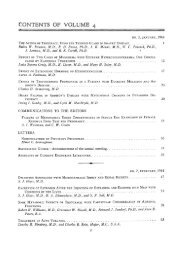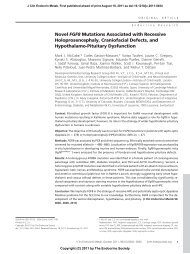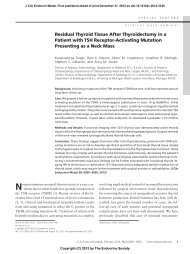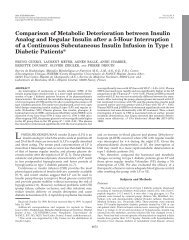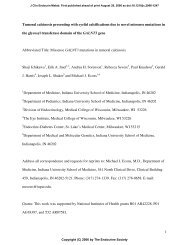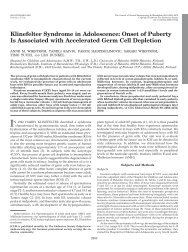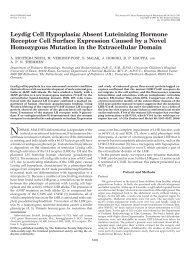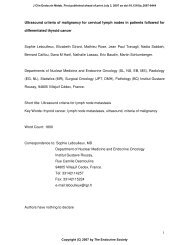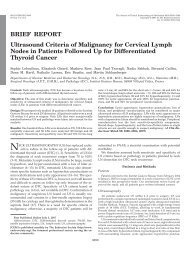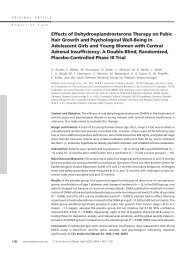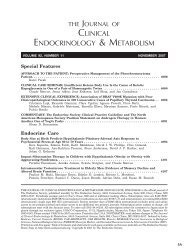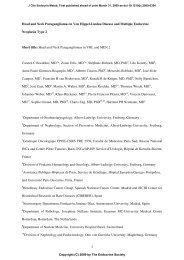Treatment - The Journal of Clinical Endocrinology & Metabolism
Treatment - The Journal of Clinical Endocrinology & Metabolism
Treatment - The Journal of Clinical Endocrinology & Metabolism
You also want an ePaper? Increase the reach of your titles
YUMPU automatically turns print PDFs into web optimized ePapers that Google loves.
J Clin Endocrinol Metab, October 2009, 94(10):3700–3707 jcem.endojournals.org 3703<br />
Laboratory analysis<br />
<strong>The</strong> laboratory analyses were performed at the different study<br />
centers. <strong>The</strong> reference intervals as well as the analysis methodology<br />
were consequently different. Also, the methods changed<br />
during the time <strong>of</strong> the study. <strong>The</strong> lower reference limit for free T 4<br />
at randomization was 8–11.7 pmol/liter, and the upper limit was<br />
18–28 pmol/liter. Disregarding the fact that different methods<br />
had been used, the levels <strong>of</strong> serum free T 4 at randomization were<br />
not different in the two groups [in group I, 56.8 (SD 18.0) pmol/<br />
liter; and in group M, 56.4 (SD 19.2) pmol/liter].<br />
Statistical analysis<br />
<strong>The</strong> primary endpoint hypothesis was tested by means <strong>of</strong> a � 2<br />
test. <strong>The</strong> influence <strong>of</strong> possible prognostic factors on the time to<br />
TAO was investigated with Cox regression analysis. <strong>The</strong> development<br />
within the various subgroups was illustrated by means <strong>of</strong><br />
Kaplan Meier technique. P values were two-sided, and P � 0.05<br />
was considered significant. <strong>The</strong> MEDLOG s<strong>of</strong>tware system (release<br />
2008-2; Information Analysis Corp., MEDLOG Systems,<br />
Crystal Bay, NV) was used for storage <strong>of</strong> data and statistical<br />
analysis.<br />
Results<br />
<strong>The</strong> two treatment groups were similar for the characteristics<br />
listed in Table 1. Among the patients randomized for<br />
iodine-131, two patients relapsed and had thyroid surgery<br />
and further radioiodine treatment, respectively. Among<br />
the patients randomized for and accounted for medical<br />
treatment, 12 patients experienced adverse events that led<br />
to change <strong>of</strong> therapy to radioiodine. Furthermore, 33<br />
(22%) <strong>of</strong> the patients randomized for medical treatment<br />
relapsed. Of those, five were treated with surgery, 25 with<br />
radioiodine, and three with further medical therapy.<br />
Among the patients in group M who received iodine-131<br />
as treatment for relapse, only one subsequently developed<br />
TAO (see Appendix II). Early administration <strong>of</strong> L-thyroxine<br />
after radioiodine treatment was not associated with<br />
arrhythmia or serious adverse effects.<br />
In patients randomized to treatment with radioiodine,<br />
a significantly higher cumulative incidence <strong>of</strong> worsening<br />
or development <strong>of</strong> TAO (63 patients; 38.7%) was observed<br />
compared with the group randomized to antithyroid<br />
drugs (32 patients; 21.3%; � 2 , P � 0.001). <strong>The</strong> log<br />
rank Mantel-Haenszel test for equality <strong>of</strong> the curves for<br />
worsening or development <strong>of</strong> TAO confirmed this difference<br />
(P � 0.001; see Fig. 2A).<br />
In the patients with TAO already at the first visit (13.1%),<br />
the overall course <strong>of</strong> the ophthalmopathy was not significantly<br />
affected by the choice <strong>of</strong> treatment, but de novo development<br />
<strong>of</strong> TAO was significantly more frequent in group<br />
I (Fig. 1; P � 0.001). Of the 41 patients with preexisting<br />
TAO, 10 patients in each group improved; one patient in<br />
group I and two patients in group M had initial improvement<br />
Number <strong>of</strong> patients<br />
60<br />
50<br />
40<br />
30<br />
20<br />
10<br />
0<br />
10<br />
9<br />
with a subsequent deterioration. Two patients in group I had<br />
no change; nine and seven patients deteriorated in groups I<br />
and M, respectively. If patients with only eyelid retraction<br />
were included in the group with preexisting TAO, a Mantel-<br />
Haenszel comparison between the treatment groups still<br />
yielded a nonsignificant difference for worsening (P �<br />
0.24) and an increased risk for de novo development <strong>of</strong><br />
TAO (P � 0.001).<br />
Independent <strong>of</strong> the choice <strong>of</strong> treatment, smoking increased<br />
the risk <strong>of</strong> worsening or development <strong>of</strong> TAO (P �<br />
0.001; Fig. 2B). However, in smokers the choice <strong>of</strong> treatment<br />
for Graves’ hyperthyroidism did not have a significant<br />
impact on the outcome (P � 0.38; Fig. 2D), in contrast to<br />
nonsmokers where iodine-131 treatment significantly increased<br />
the risk <strong>of</strong> worsening or development <strong>of</strong> TAO (P �<br />
0.001; Fig. 2C).<br />
In a Cox regression analysis, both the choice <strong>of</strong> therapy<br />
and smoking habits were shown to influence the risk <strong>of</strong><br />
worsening or development <strong>of</strong> TAO (Table 2). <strong>The</strong> effect <strong>of</strong><br />
therapy for hyperthyroidism on the time to worsening or<br />
development <strong>of</strong> TAO was significantly different in the<br />
group <strong>of</strong> smokers and nonsmokers (P � 0.01). In the Cox<br />
regression statistics, this was analyzed by using the interaction<br />
term iodine-131 therapy in smokers (Table 2). <strong>The</strong><br />
differences are demonstrated graphically in Fig. 2, C and D.<br />
<strong>The</strong> associations between TAO and pretreatment laboratory<br />
levels <strong>of</strong> thyroid hormone could merely be estimated,<br />
because the methods and reference intervals differed<br />
between the centers. However, taking these limitations into<br />
consideration, the Cox regression analysis suggested that<br />
higher free T 4 levels were associated with an increased risk<br />
for TAO (Table 2).<br />
In the post hoc analysis, using the set criteria for the<br />
change in TAO, worsening or development <strong>of</strong> TAO was<br />
also found to occur more <strong>of</strong>ten in group I (40 patients;<br />
25%) than in group M (16 patients; 11%; P � 0.002). <strong>The</strong><br />
Mantel-Haenszel comparisons between different groups<br />
as shown in Fig. 2, A–D, showed comparable results. <strong>The</strong><br />
53<br />
23<br />
worse pre-existing new development<br />
Iodine-131<br />
Medical<br />
FIG. 1. Number <strong>of</strong> patients with worsening <strong>of</strong> preexisting TAO [10 <strong>of</strong><br />
22 patients (45%) in group I; and nine <strong>of</strong> 19 patients (47%) in group<br />
M] and de novo development <strong>of</strong> TAO [53 <strong>of</strong> 141 patients (38%) in<br />
group I; and 23 <strong>of</strong> 131 patients (18%) in group M] at any time during<br />
follow-up.



